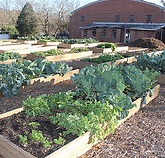This series explains how to create and manage a community or school garden, from planning, siting and building the garden itself to choosing what to plant and how to grow it successfully to properly caring for garden tools.
14 publications were found in this series
-
Community and School Gardens Series: Planning an Edible Garden (C 1027-1) This publication describes three steps for planning a school garden: garden location, soil and terrain, and choosing crops.
-
Community and School Gardens Series: Growing Fruits (C 1027-10) Community gardens designed to provide locally grown food for families can be used to grow fruits in addition to the more commonly grown vegetables. There are many common and lesser-known fruits that a…
-
Community and School Gardens Series: Sources of Water for the Garden (C 1027-11) This publication discusses the advantages and disadvantages of various sources of water for a community or school garden, including municipal water, rivers or creeks, ponds, wells and rainwater.
-
Community and School Gardens Series: Irrigation (C 1027-12) This publication describes irrigation methods suitable for community or school gardens, including overhead sprinklers, hand watering and drip irrigation.
-
Community and School Gardens Series: Weed Control (C 1027-13) This publication describes weed control methods that are appropriate for community and school gardens.
-
Community and School Gardens Series: Extending the Crop Season: Unheated Spaces (C 1027-14) This publication describes common myths about cold protection and provides options for protecting plants from the cold in community and school gardens, including cold frames, row covers and hoop house…
-
Community and School Gardens Series: Siting a Garden (C 1027-2) This publication provides recommendations for properly siting a school or community garden, taking into account sunlight exposure, water availability, slope, garden access, tool storage, compost bins …
-
Community and School Gardens Series: Raised Beds vs. In-Ground Gardens (C 1027-3) This publication describes the advantages and disadvantages of raised bed and in-ground gardens and may be used as a guide when planning a community or school garden project.
-
Community and School Gardens Series: Raised Garden Bed Dimensions (C 1027-4) This publication helps determine the ideal dimensions of raised beds for community and school gardens by focusing on three things: materials, slope and accessibility.
-
Community and School Gardens Series: Raised Bed Materials (C 1027-5) This publication describes the advantages and disadvantages of various materials used for building raised beds, including types of wood, composite materials, recycled materials, and kits.
-
Community and School Gardens Series: Less Expensive Sources of Plant Material, Amendments and Tools (C 1027-6) This publication offers advice on finding less expensive sources of plant material, amendments and tools for community and school gardens.
-
Community and School Gardens Series: Garden Sheds (C 1027-7) This publication provides information about storage sheds for community and school gardens, including local building codes, siting a shed, and alternatives to traditional sheds.
-
Community and School Gardens Series: Stocking the Toolshed: Hand Tools (C 1027-8) This publication describes the types and quantities of hand tools that work best for community and school gardens, including shovels, rakes, trowels, hand pruners, gloves, children's tools, and carts …
-
Community and School Gardens Series: Garden Fencing (C 1027-9) This publication describes options for fencing a community or school garden, including fence types and materials.

